 W
WBarabus was a winter public transport in 19th – early 20th centuries, probably the first public transport in Kazan after cabs. They were operated by private carriers who were poor Tatar commoners from surrounding villages. A typical barabus was a sledge sheeted with sacking. Barabus was a transport of paupers competing with cabs, horse railways and later tramway. Until the 1930s, when trams were installed in the suburbs and any private enterprise was prohibited, barabuses were the only transport to connect quarters of poor mill-hands with other parts of the city.
 W
WA barouche is a large, open, four-wheeled carriage, both heavy and luxurious, drawn by two horses. It was fashionable throughout the 19th century. Its body provides seats for four passengers, two back-seat passengers vis-à-vis two behind the coachman's high box-seat. A leather roof can be raised to give back-seat passengers some protection from the weather.
 W
WA cabriolet is a light horse-drawn vehicle, with two wheels and a single horse. The carriage has a folding hood that can cover its two occupants, one of whom is the driver. It has a large rigid apron, upward-curving shafts, and usually a rear platform between the C springs for a groom. The design was developed in France in the eighteenth century and quickly replaced the heavier hackney carriage as the vehicle for hire of choice in Paris and London.
 W
WA carriage is a private four-wheeled vehicle for people and is most commonly horse-drawn. Second-hand private carriages were common public transport, the equivalent of modern cars used as taxis. Carriage suspensions are by leather strapping and, on those made in recent centuries, steel springs. Two-wheeled carriages are informal and usually owner-driven.
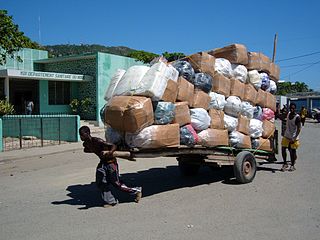 W
WA cart or dray is a vehicle designed for transport, using two wheels and normally pulled by one or a pair of draught animals. A handcart is pulled or pushed by one or more people.
 W
WA charabanc or "char-à-banc" is a type of horse-drawn vehicle or early motor coach, usually open-topped, common in Britain during the early part of the 20th century. It has "benched seats arranged in rows, looking forward, commonly used for large parties, whether as public conveyances or for excursions." It was especially popular for sight-seeing or "works outings" to the country or the seaside, organised by businesses once a year. The name derives from the French char à bancs, the vehicle having originated in France in the early 19th century.
 W
WA chariot is a type of carriage driven by a charioteer, usually using horses to provide rapid motive power. Chariots were used by armies as transport or mobile archery platforms, for hunting or for racing, and as a conveniently fast way to travel for many ancient people.
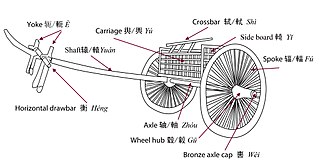 W
WThe ancient Chinese chariot was used as an attack and pursuit vehicle on the open fields and plains of ancient China from around 1200 BCE. Chariots also allowed military commanders a mobile platform from which to control troops while providing archers and soldiers armed with dagger-axes increased mobility. They reached a peak of importance during the Spring and Autumn period, but were largely superseded by cavalry during the Han Dynasty.
 W
WA coach is a large closed four-wheeled passenger-carrying vehicle or carriage usually drawn by two or more horses usually controlled by a coachman occasionally accompanied by a postilion but always accompanied by footmen ready to handle unruly horses. A coach has doors in its sides and a front and a back seat inside. The driver has a seat in front raised up high to give good vision. It is often called a box, box seat or coach box. The word coach came into use in the 15th century and spread across Europe. There are a number of types of coach depending on how the vehicle is to be used. Special breeds of horses, such as the now-extinct Yorkshire Coach Horse, were developed to pull the heavy coaches.
 W
WConcord coaches are horse-drawn coaches, often used as stagecoaches, which employ a style of suspension and construction particularly suited to North America's early 19th century roads. Leather thoroughbraces suspend passengers who are in constant motion while the coach is moving. The swaying is accepted by passengers for the shock absorbing action of the leather straps and for the way the special motion eases the coach over very rough patches of roadway. The coaches were first developed and built by coachbuilder J Stephen Abbot and wheelwright Lewis Downing of Concord, New Hampshire. They were high-end, expensive vehicles; the cost was justified by long service life. The thoroughbrace suspension reduced stresses on the structure and improved passenger comfort.
 W
WA corf also spelt corve in mining is a wicker basket or a small human powered minecart for carrying or transporting coal, ore, etc. Human powered corfs had generally been phased out by the turn of the 20th century, with horse drawn corfs having been mostly replaced by horse drawn or motorised minecarts mounted on rails by the late 1920s. Also similar is a Tram, originally a box on runners, dragged like a sledge.
 W
WA dog sled or dog sleigh is a sled pulled by one or more sled dogs used to travel over ice and through snow. Numerous types of sleds are used, depending on their function. They can be used for dog sled racing. In Greenland the dogs pull in a fan shape in front of the sled, while in other regions, such as Alaska and Canada the dogs pull side by side in pairs.
 W
WDurant-Dort Carriage Company was a manufacturer of horse-drawn vehicles in Flint, Michigan. Founded in 1886, by 1900 it was the largest carriage manufacturer in the country.
 W
WAn ekka is a one-horse carriage used in northern India. Ekkas were something like 'traps', and were commonly used as cabs, or private hire vehicles in 19th-century India. They find frequent mention in colonial literature of the period. It is also said that some kind of ekkas were used by people of Indus Valley Civilisation.
 W
WExperiment was an early 19th-century boat powered by horses and incorporating the idea of a screw propeller, which was a new idea at the time.
 W
WA float is a form of two-wheeled horse-drawn cart with a dropped axle to give an especially low load-bed.
 W
WA gig, also called chair or chaise, is a light, two-wheeled sprung cart pulled by one horse.
 W
WA governess cart is a small two-wheeled horse-drawn cart. Their distinguishing feature is a small tub body, with two opposed inward-facing seats. They could seat four, although there was little room for four large adults. The driver sat sideways on one of these seats. The centre rear of the body was lowered, or else had a small hinged door, and there was a step beneath. The wheels were of moderate size, always fitted with mudguards, and usually carried on elliptical springs. The axle was either straight or dropped, giving a low, stable, centre of gravity.
 W
WHorse artillery was a type of light, fast-moving, and fast-firing artillery which provided highly mobile fire support, especially to cavalry units. Horse artillery units existed in armies in Europe, the Americas, and Asia, from the 17th to the mid 20th century. A precursor of modern self-propelled artillery, it consisted of light cannons or howitzers attached to light but sturdy two-wheeled carriages called caissons or limbers, with the individual crewmen riding on horses. This was in contrast to the rest of the field artillery, which were also horse-drawn but whose gunners were normally transported seated on the gun carriage, wagons or limbers.
 W
WA horse-drawn boat or tow-boat is a historic boat operating on a canal, pulled by a horse walking beside the canal on a towpath.
 W
WA horse-drawn vehicle is a mechanized piece of equipment pulled by one horse or by a team of horses. These vehicles typically had two or four wheels and were used to carry passengers and/or a load. They were once common worldwide, but they have mostly been replaced by automobiles and other forms of self-propelled transport.
 W
WA horse-bus or horse-drawn omnibus was a large, enclosed and sprung horse-drawn vehicle used for passenger transport before the introduction of motor vehicles. It was mainly used in the late 19th century in both the United States and Europe, and was one of the most common means of transportation in cities. In a typical arrangement, two wooden benches along the sides of the passenger cabin held several sitting passengers facing each other. The driver sat on a separate, front-facing bench, typically in an elevated position outside the passengers' enclosed cabin. In the main age of horse buses, many of them were double-decker buses. On the upper deck, which was uncovered, the longitudinal benches were arranged back to back.
 W
WA howdah, or houdah, derived from the Arabic هودج (hawdaj), which means "bed carried by a camel", also known as hathi howdah, is a carriage which is positioned on the back of an elephant, or occasionally some other animal such as a camel, used most often in the past to carry wealthy people during progresses or processions, hunting or in warfare. It was also a symbol of wealth for the owner and as a result was decorated with expensive gemstones.
 W
WThe karozzin is a Maltese traditional mode of transport consisting of a carriage pulled by a horse or pair of horses. It was once popular for general transit and is still used in ceremonies such as funerals, and as a tourist attraction. It is mostly found at Mdina and Valletta, and dates to the mid-nineteenth century.
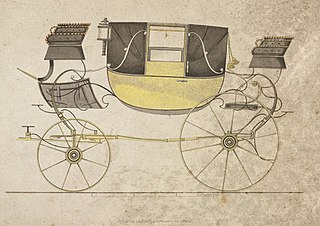 W
WA landau is a coachbuilding term for a type of four-wheeled, convertible carriage. It was a city carriage of luxury type. The low shell of the landau provides maximal visibility of the occupants and their clothing, a feature that makes a landau still a popular choice for the Lord Mayors of certain cities in the United Kingdom on ceremonial occasions.
 W
WThe litter is a class of wheelless vehicles, a type of human-powered transport, for the transport of persons. Smaller litters may take the form of open chairs or beds carried by two or more carriers, some being enclosed for protection from the elements. Larger litters, for example those of the Chinese emperors, may resemble small rooms upon a platform borne upon the shoulders of a dozen or more people. To most efficiently carry a litter, porters either place the carrying poles directly upon their shoulders or use a yoke to transfer the load from the carrying poles to the shoulders.
 W
WA pantechnicon van, usually shortened to pantec, was originally a furniture removal van drawn by horses and used by the British company "The Pantechnicon" for delivering and collecting furniture which its customers wished to store. The name is a word largely of British English usage.
 W
WA post-chaise is a fast carriage for traveling post built in the 18th and early 19th centuries. It usually had a closed body on four wheels, sat two to four persons, and was drawn by two or four horses.
 W
WRudas is a Hungarian word and surname, literally meaning "of rúd, pole-horse with carriage, wagon" :
 W
WLeonhard "Sepp" Seppala was a Norwegian sled dog breeder, trainer and musher who played a pivotal role in the 1925 serum run to Nome and participated in the 1932 Winter Olympics. Seppala introduced the work dogs used by Native Siberians at the time to the American public; the breed came to be known as the Siberian Husky in the English-speaking world. The Leonhard Seppala Humanitarian Award, which honors excellence in sled dog care, is named in honour of him.
 W
WA sled, sledge, or sleigh is a land vehicle that slides across a surface, usually of ice or snow. It is built with either a smooth underside or a separate body supported by two or more smooth, relatively narrow, longitudinal runners similar in principle to skis. This reduces the amount of friction, which helps to carry heavy loads.
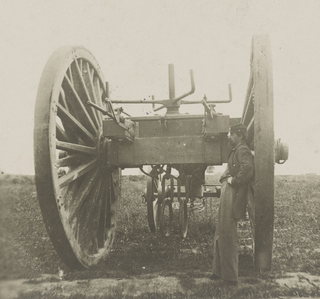 W
WA sling cart is used to transport very heavy objects over land. The cart has a skeletal frame with large-diameter wheels so the object being transported can be suspended above the ground by ropes or chains below the level of the axle. Typical sling carts have two wheels on a single axle with a long pole or tongue perpendicular to the axle for use as a lever. In the days of muzzle-loading cannon, sling carts were used to move heavy artillery from the place of manufacture or storage to a ship or fortification where the gun would be placed on a gun carriage. Specialized sling carts with two axles and four wheels were used to carry the heaviest guns. Smaller field guns were often transported on their gun carriage, but portable gun carriages were unable to withstand the recoil energy of very large guns.
 W
WStage wagons are light horse-drawn or mule-drawn public passenger vehicles often referred to as stagecoaches. Like stagecoaches they made long scheduled trips using stage stations or posts where the horses would be replaced by fresh horses. Stage wagons were intended for use in particularly difficult conditions where standard stagecoaches would be too big and too heavy.
 W
WA stagecoach is a four-wheeled public coach used to carry paying passengers and light packages on journeys long enough to need a change of horses. It is strongly sprung and generally drawn by four horses.
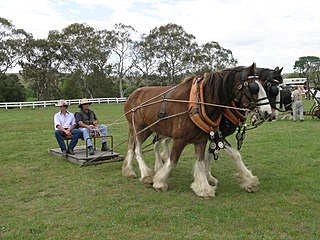 W
WA stone-boat is a type of sled (sledge) for moving heavy objects such as stones or hay bales. Originally they were for animal-powered transport used with horses or oxen to clear fields of stones and other uses and may still be used with animals or tractors today .
 W
WA sulky is a lightweight cart with two wheels and a seat for the driver only but usually without a body, generally pulled by horses or dogs, which is used for harness races. The term is also used for a light stroller, an arch mounted on wheels or crawler tracks, used in logging, or other types of vehicle having wheels and usually a seat for the driver, such as a plough, lister or cultivator.
 W
WTandem, or in tandem, is an arrangement in which a team of machines, animals or people are lined up one behind another, all facing in the same direction.
 W
WA tonga or tanga is a light carriage or curricle drawn by one horse used for transportation in the Indian subcontinent. They have a canopy over the carriage with a single pair of large wheels. The passengers reach the seats from the rear while the driver sits in front of the carriage. Some space is available for baggage below the carriage, between the wheels. This space is often used to carry hay for the horses.
 W
WTelega is a type of four-wheel horse-drawn vehicle, whose primary purpose is to carry loads, similar to a wain, known in Russia and other countries. It has been defined as "a special type commonly used in the southern and south-western provinces for the carriage of grain, hay and other agricultural products".
 W
WA travois is a historical frame structure that was used by indigenous peoples, notably the Plains Aboriginals of North America, to drag loads over land.
 W
WA tumbrel is a two-wheeled cart or wagon typically designed to be hauled by a single horse or ox. Their original use was for agricultural work; in particular they were associated with carrying manure. Their most infamous use was taking prisoners to the guillotine during the French Revolution. They were also used by the military for hauling supplies. In this use the carts were sometimes covered. The two wheels allowed the cart to be tilted to discharge its load more easily.
 W
WA vardo is a traditional horse-drawn wagon used by British Romanichal Travellers as their home. Possessing a chimney, it is commonly thought of as being highly decorated, intricately carved, brightly painted, and even gilded. The Romanichal Traveller tradition of the vardo is seen as a high cultural point of both artistic design and a masterpiece of woodcrafters art. The heyday of the living wagon lasted for roughly 70 years, from the mid-1800s through the first two decades of the twentieth century. Not used for year-round living today, they are shown at the Romanichal horse fairs held throughout the year, the best known of which is Appleby Horse Fair.
 W
WVozok (возок) is a type of closed winter sled that was used throughout Russia until the late 19th century. With the aim of reducing heat loss, the vozok usually had very small windows and sometimes a furnace to keep it warm. Inside it was quite dark.
 W
WA wagonette is a small horsecar with springs, which has two benches along the right and left side of the platform, people facing each other. The driver sits on a separate, front-facing bench. A wagonette may be open or have a tilt. A large horse-drawn enclosed vehicle with spring-suspension, a similar arrangement of the seats and obligatory roof is called a horsebus.
 W
WA wheelbarrow is a small hand-propelled vehicle, usually with just one wheel, designed to be pushed and guided by a single person using two handles at the rear, or by a sail to push the ancient wheelbarrow by wind. The term "wheelbarrow" is made of two words: "wheel" and "barrow." "Barrow" is a derivation of the Old English "bearwe" which was a device used for carrying loads.